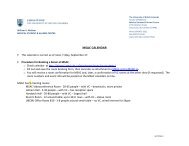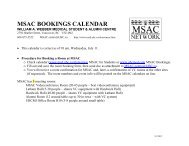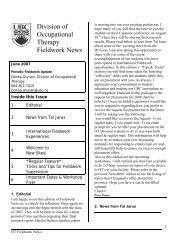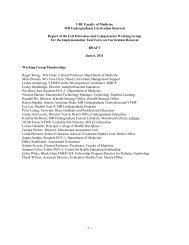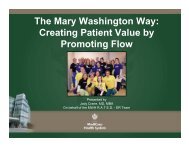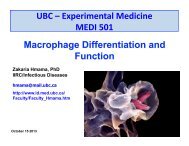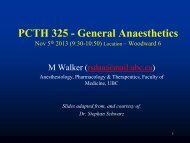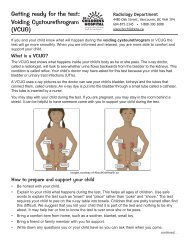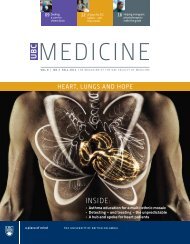MEDICINE
download a copy - University of British Columbia Faculty of Medicine
download a copy - University of British Columbia Faculty of Medicine
- No tags were found...
Create successful ePaper yourself
Turn your PDF publications into a flip-book with our unique Google optimized e-Paper software.
6 FOCUS UBC <strong>MEDICINE</strong> ON:<br />
Environmental<br />
Health<br />
Ryon Anas participates in<br />
an experiment in Chris Carlsten’s<br />
Air Pollution Exposure Laboratory.<br />
Photo credit: Don Erhardt<br />
Continued from p. 5<br />
genes, leading to significant changes in how cells develop<br />
and function.<br />
The connection between parents’ smoking and children’s asthma<br />
is already well established, but much like diesel exhaust, it’s<br />
a circumstantial case, based on statistics about patterns of<br />
behaviour and illness. So even though smoking is a “risk factor”<br />
for asthma, it hasn’t proven to be a cause.<br />
Dr. Daley’s team is pursuing the hypothesis that exposure to smoke<br />
causes changes in methylation patterns that, in turn, trigger a<br />
cascade of reactions leading to childhood asthma, and possibly<br />
allergies as well.<br />
In trying to prove that theory, they will try to identify where in the<br />
genome methylation takes place. Using powerful computers,<br />
they will then search for patterns and correlations based on data<br />
about the donors – whether the parents smoked, whether the<br />
children were exposed to smoke in the womb or in early childhood,<br />
and whether the children suffer from asthma or allergies.<br />
Once Dr. Daley has identified areas of methylation and correlations<br />
with smoking, asthma and allergies, her collaborator, Professor of<br />
Medicine Andrew Sandford, will seek to identify what those areas<br />
of DNA instruct their host cells to do.<br />
“What is that mechanism?” Dr. Daley says. “If we know it, we might<br />
be able to intervene, depending on the child’s genetic profile.”<br />
Maybe that intervention would be a drug. More likely, it would be<br />
a variety of recommendations for the parent that would counteract<br />
or mute the effects of the turned-off gene – such as bringing a dog<br />
into the home, or removing a dog from the home, depending on the<br />
child’s genotype. Other recommendations could touch on diet or<br />
physical activity.<br />
“We may have very targeted environmental solutions that may be<br />
different, based on what your genes are,” says Dr. Daley, a Canada<br />
Research Chair in Genetic Epidemiology of Common Complex<br />
Diseases and a Career Scholar of the Michael Smith Foundation<br />
for Health Research.<br />
Of course, recommendations are only as good as the person who<br />
is supposed to follow them. Although warnings about smoking –<br />
and especially smoking while pregnant – have been enormously<br />
effective, some expectant mothers still do it. But if doctors can point<br />
to a child’s genetic profile while conveying the need to take certain<br />
steps, Dr. Daley believes the message might carry more weight.<br />
“We’re not far from determining a child’s susceptibility,” she says.<br />
“If we can identify what types of gene-environment interactions<br />
they are susceptible to, then, working with the parents, we might<br />
be able to modify their environment.”<br />
Dr. Carlsten, while believing tobacco use has “no redeeming<br />
value” and therefore should be choked off as quickly as possible<br />
through bans and taxes, has focused on what might seem a more<br />
intractable problem. After all, diesel exhaust isn’t the product of<br />
a bad habit, but the product of transportation – the lifeblood of<br />
industrialized and developing economies.<br />
All the more reason, he believes, to find the proof of harm. Thus,<br />
he maintains a steady stream of volunteers willing to spend a<br />
couple of hours – usually several<br />
times – in his Air Pollution<br />
Exposure Laboratory.<br />
Frozen vials of DNA being used<br />
to determine whether early life<br />
exposure to smoking affects<br />
gene expression. Photo credit:<br />
Brian Kladko<br />
“At the end of the day, any effort<br />
to change regulations about<br />
diesel exhaust will very likely be<br />
challenged in court,” he says. “When<br />
you have experimental studies,<br />
that changes the whole story<br />
very powerfully. If the community<br />
believes you’ve demonstrated<br />
a mechanism by which harm is<br />
inflicted, the effort gains credibility.”<br />
Dr. Carlsten has uncovered solid evidence of his oxidative stress<br />
theory, by giving his subjects anti-oxidants before exposing<br />
them to exhaust. The result: their lungs don’t constrict as much<br />
as they do when not given antioxidants. He also has found that<br />
exhaust exposure causes a rise in a type of micro-RNA that plays<br />
a role in immunity (and thus inflammation), and has determined<br />
that anti-oxidants prevent that increase.<br />
While it’s reasonable to think that anti-oxidants might thus have<br />
potential as a preventive therapy for asthma, Dr. Carlsten would<br />
rather see the findings used to justify a requirement for diesel<br />
engines to produce fewer oxidizing particles.<br />
“I’m not a big supporter of anything that seems like a treatment,<br />
because that’s avoiding the fundamental problem,” he says. “It’s<br />
much more important to me to validate the plausibility of what<br />
we’re seeing epidemiologically, so we can decrease air pollution<br />
and protect the entire population.”



